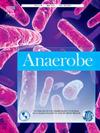描述从牙科生物膜中分离出的三个新的 Leptotrichia 物种:Leptotrichia rugosa sp.
IF 2.6
3区 生物学
Q3 MICROBIOLOGY
引用次数: 0
摘要
从人口腔生物膜中分离到3株细菌,分别为HSP-334T、HSP-342T和HSP-536T。这些菌株被鉴定为革兰氏阴性,直或微弯曲厌氧菌。基于16S rRNA基因分析,菌株HSP-334T与沙希细毛菌LB37T的同源性最接近(92.25%)。菌株HSP-342T与香港钩毛菌HKU24T相似度最高(98.03%),菌株HSP-536T与颊钩毛菌DSM 1135T相似度最高(97.77%)。值得注意的是,3个分离株的最大序列相似性在91.56% ~ 94.12%之间。所有系统发育结果表明,菌株HSP-334T、HSP-342T、HSP-536T、细毛菌属和假细毛菌JCM 16774T均聚集在细毛菌科的一个亚枝上。结果表明,这3株菌株及其亲缘种的平均核苷酸同一性(ANI)和数字DNA-DNA杂交(dDDH)值均低于已建立的种划分阈值。在这些新菌株中检测到的主要细胞脂肪酸为C16:0和C18:1ω7c。菌株HSP-334T、HSP-342T和HSP-536T可以通过几个表型特征进行区分。综合多相分类鉴定结果表明,菌株HSP-334T、HSP-342T和HSP-536T代表细毛菌属的3个新种,其中命名为细毛菌(Leptotrichia rugosa sp. nov.)(型菌株HSP-334T = JCM 36566T = CGMCC 1.18095T = MCCC 1K09354T);提出了嗜中毛纤毛菌11 .(型菌株HSP-342T = JCM 36567T = CGMCC 1.18052T = MCCC 1K09338T)和白毛纤毛菌11 .(型菌株HSP-536T = JCM 36662T = CGMCC 1.18096T = MCCC 1K09339T)。本文章由计算机程序翻译,如有差异,请以英文原文为准。
Description of three new Leptotrichia species isolated from dental biofilm: Leptotrichia rugosa sp. nov., Leptotrichia mesophila sp. nov. and Leptotrichia alba sp. nov.
Three bacterial strains, namely HSP-334T, HSP-342T and HSP-536T, were isolated from human oral dental biofilm. These strains were identified as Gram stain-negative, straight or slightly curved anaerobes. Based on 16S rRNA genes analysis, strain HSP-334T exhibited the closest identity to Leptotrichia shahii LB37T (92.25 %). Strain HSP-342T demonstrated the highest similarity to Leptotrichia hongkongensis HKU24T (98.03 %), while strain HSP-536T displayed the greatest resemblance to Leptotrichia buccalis DSM 1135T (97.77 %). Notably, the maximum sequence similarity among the three isolates ranged from 91.56 % to 94.12 %. All the phylogenies showed that strains HSP-334T, HSP-342T, HSP-536T, all members of genus Leptotrichia and Pseudoleptotrichia goodfellowii JCM 16774T were clustered in one subclade within the family Leptotrichiaceae. The average nucleotide identity (ANI) and digital DNA-DNA hybridization (dDDH) values calculated between these three strains and their phylogenetically related species were determined to be lower than the established species delineation threshold values. The major cellular fatty acids detected in these novel strains were C16:0 and C18:1 ω7c. Strains HSP-334T, HSP-342T and HSP-536T could be distinguished from each other by several phenotypic characteristics. Based on the comprehensive polyphasic taxonomic characterizations conducted, strains HSP-334T, HSP-342T and HSP-536T represent three novel species of the genus Leptotrichia, for which the name Leptotrichia rugosa sp. nov. (type strain HSP-334T = JCM 36566T = CGMCC 1.18095T = MCCC 1K09354T), Leptotrichia mesophila sp. nov. (type strain HSP-342T = JCM 36567T = CGMCC 1.18052T = MCCC 1K09338T) and Leptotrichia alba sp. nov. (type strain HSP-536T = JCM 36662T = CGMCC 1.18096T = MCCC 1K09339T) are proposed.
求助全文
通过发布文献求助,成功后即可免费获取论文全文。
去求助
来源期刊

Anaerobe
生物-微生物学
CiteScore
5.20
自引率
8.70%
发文量
137
审稿时长
76 days
期刊介绍:
Anaerobe is essential reading for those who wish to remain at the forefront of discoveries relating to life processes of strictly anaerobes. The journal is multi-disciplinary, and provides a unique forum for those investigating anaerobic organisms that cause infections in humans and animals, as well as anaerobes that play roles in microbiomes or environmental processes.
Anaerobe publishes reviews, mini reviews, original research articles, notes and case reports. Relevant topics fall into the broad categories of anaerobes in human and animal diseases, anaerobes in the microbiome, anaerobes in the environment, diagnosis of anaerobes in clinical microbiology laboratories, molecular biology, genetics, pathogenesis, toxins and antibiotic susceptibility of anaerobic bacteria.
 求助内容:
求助内容: 应助结果提醒方式:
应助结果提醒方式:


